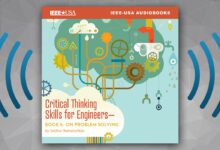
In March, IEEE-USA E-BOOKS will offer Women in Engineering — Book 1: Inspire and Close the Gender Gap, free to IEEE members.
IEEE-USA’s award-winning Women in Engineering e-book series has two purposes: to present a high-level overview about women in Science, Technology, Engineering and Mathematics (STEM) fields, and to provide first-hand accounts of the professional journeys of some notable contemporary female engineers.
When reading Book 1 (Vol. 1), readers should note that data representing a global perspective on the issue of women in STEM fields is included, wherever available. Employment, education and statistical data are most readily available and detailed for the United States, so many of the statistics and trends identified pertain strictly to the United States. This volume is not meant to be a comprehensive study. The topic of women in the workforce — particularly the STEM workforce — is complex, varied, and perhaps best appreciated when studied from multiple vantage points.
Over the past few decades, women’s participation in the workforce has increased significantly. Women are earning a larger share of university degrees, and the demand for STEM-educated professionals has grown more than four times the rate of the U.S. labor force as a whole. Nevertheless, women’s representation in STEM occupations has remained relatively flat — or is decreasing — worldwide.
In Book 1 (Volume 1), Inspire and Close the Gender Gap, author Nita Patel examines the questions: How many women pursue STEM career fields? Why are more women not graduating with STEM degrees? How can we recruit and retain women in engineering?
Engineering Stereotypes
Patel points out that encouragement and messaging through all ages is important in changing the number of young girls pursuing STEM careers.
According to the Girl Scout Research Institute report, Generation STEM: What Girls Say about Science, Technology, Engineering and Math:
- Almost three quarters (74 percent) of U.S. high school girls are interested in STEM fields and subjects. Girls are interested in the process of learning, asking questions, problem solving and doing hands-on activities.
- Girls want to help people and make a difference in the world.
The book reveals that, according to a careers research study (Britain’s Got Talented Female Engineers), most women engineers (91 percent) had at least one inspirational teacher, 75 percent were interested in problem solving/fixing things, and the majority knew one or more engineers.
“Young girls are interested in STEM,” Patel writes, “and teachers or parents have usually influenced the majority of women practicing in STEM careers to pursue STEM studies.” Further, it follows that teachers, counselors, parents and adult role models should actively encourage young girls to consider STEM careers.
Moreover, according to this study, three-fourths of women in engineering still believe the public still regards engineering as a male career; and over half said they felt young girls were put off by the idea that engineering is too difficult.
In addition, according to a 2007 study by the Royal Academy of Engineering (and several similar studies conducted around the world), the people most likely to influence young girls in the pursuit of STEM careers do not understand what an engineer or scientist does. The top ten associations/words influencers cited for “Engineer” include: mechanic/mechanical; building/construction; cars; machinery/machines; bridges; engines; structural; hard work; technical; and trains.
What Can You Do To Help?
Patel notes the reasons why more young girls are not pursuing STEM studies continues to be a popular discussion. The issues are complex and nuanced, she writes; however, a few key themes (e.g., public stereotypes, inherent biases and lack of role models) do emerge. Many organizations, including IEEE Women in Engineering, are focusing on how to inspire, engage and include more young girls in STEM professions. Although ready solutions have presented themselves — Patel says developing one-on-one mentoring relationships, providing female role models, and increasing the awareness of inaccurate biases and stereotypes can make a difference.
Now through 15 April, IEEE members can get a free download of this e-book by going to: https://ieeeusa.org/product/women-in-engineering-book-1-volume-1-inspire-and-close-the-gender-gap/Log in with your IEEE Web account, add the book to your cart, and use promo code MARFREE17 at checkout.
March is Women’s History Month and 8 March is International Women’s Day — get your free e-book for members to find out more about women in engineering!






